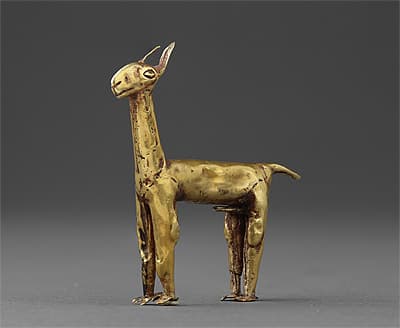
INCA culture 1400 – 1533 AD
Llama 1400-1533 AD gold5.5 (h) x 4.9 (w) cm Museo Oro del Perú, Lima Photograph: Daniel Giannoni
Gold offerings to the dead were important because of the immutability of the metal: unlike silver and copper, it did not tarnish, nor did it rot like food and textiles. One manifestation of the power of the Inca himself was his monopoly of the distribution of gold. He represented the sun on earth, and gold symbolised the sun. Because the emperor still remained even after death—each Inca’s tomb was attended in perpetuity in his Cuzco palace—gold symbols were buried with each noble’s mummy. Among the objects were small male llamas, which provided wealth, meat, fibre and transport in life, and therefore would still be needed after death.
These tiny figurines were normally made of hammered gold sheets, joined by soldering at the side. They were formed by creating tubes for the body, head, ears, tail and penis, but stood on flat feet. Gold was rarely mined like silver and copper, but obtained from river sand or looted from Moche and Chimú cemeteries and tombs. For the Incans, only their own dead deserved respect.
The metalsmiths of the Inca Empire used the same techniques for smelting and working gold as their predecessors, but rarely reached the extraordinary technical heights of earlier cultures. They famously kidnapped the smiths after their final conquest of the Kingdom of Chimor in about 1470, and used them to make gold and silver decorations for the temples and palaces of Cuzco. Most Inca gold was stolen by the Spanish, including some famous life-size statues of llamas.
Christine Dixon
Gold offerings to the dead were important because of the immutability of the metal: unlike silver and copper, it did not tarnish, nor did it rot like food and textiles. One manifestation of the power of the Inca himself was his monopoly of the distribution of gold. He represented the sun on earth, and gold symbolised the sun. Because the emperor still remained even after death—each Inca’s tomb was attended in perpetuity in his Cuzco palace—gold symbols were buried with each noble’s mummy. Among the objects were small male llamas, which provided wealth, meat, fibre and transport in life, and therefore would still be needed after death.
These tiny figurines were normally made of hammered gold sheets, joined by soldering at the side. They were formed by creating tubes for the body, head, ears, tail and penis, but stood on flat feet. Gold was rarely mined like silver and copper, but obtained from river sand or looted from Moche and Chimú cemeteries and tombs. For the Incans, only their own dead deserved respect.
The metalsmiths of the Inca Empire used the same techniques for smelting and working gold as their predecessors, but rarely reached the extraordinary technical heights of earlier cultures. They famously kidnapped the smiths after their final conquest of the Kingdom of Chimor in about 1470, and used them to make gold and silver decorations for the temples and palaces of Cuzco. Most Inca gold was stolen by the Spanish, including some famous life-size statues of llamas.
Christine Dixon
Gold offerings to the dead were important because of the immutability of the metal: unlike silver and copper, it did not tarnish, nor did it rot like food and textiles. One manifestation of the power of the Inca himself was his monopoly of the distribution of gold. He represented the sun on earth, and gold symbolised the sun. Because the emperor still remained even after death—each Inca’s tomb was attended in perpetuity in his Cuzco palace—gold symbols were buried with each noble’s mummy. Among the objects were small male llamas, which provided wealth, meat, fibre and transport in life, and therefore would still be needed after death.
These tiny figurines were normally made of hammered gold sheets, joined by soldering at the side. They were formed by creating tubes for the body, head, ears, tail and penis, but stood on flat feet. Gold was rarely mined like silver and copper, but obtained from river sand or looted from Moche and Chimú cemeteries and tombs. For the Incans, only their own dead deserved respect.
The metalsmiths of the Inca Empire used the same techniques for smelting and working gold as their predecessors, but rarely reached the extraordinary technical heights of earlier cultures. They famously kidnapped the smiths after their final conquest of the Kingdom of Chimor in about 1470, and used them to make gold and silver decorations for the temples and palaces of Cuzco. Most Inca gold was stolen by the Spanish, including some famous life-size statues of llamas.
Christine Dixon

